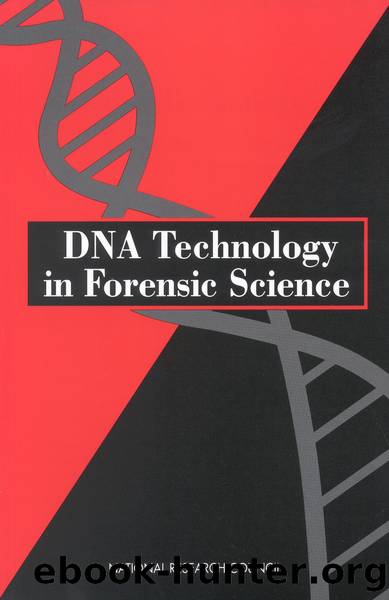DNA Technology in Forensic Science by Committee on DNA Technology in Forensic Science

Author:Committee on DNA Technology in Forensic Science
Language: eng
Format: epub
Tags: Biology and Life Sciences : Genetics
Publisher: NATIONAL ACADEMY PRESS
Published: 1992-01-01T00:00:00+00:00
TOWARD A FIRM FOUNDATION FOR STATISTICAL INTERPRETATION
Statistical interpretation of DNA typing evidence has probably yielded the greatest confusion and concern for the courts in the application of DNA to forensic science. Some courts have accepted the multiplication rule based on the grounds of allelic independence, others have used various ad hoc corrections to account for nonindependence, and still others have rejected probabilities altogether. Some courts have ruled that it is unnecessary even to test allelic independence, and others have ruled that allelic independence cannot be assumed without proof. The confusion is not surprising, inasmuch as the courts have little expertise in population genetics or statistics.
In reaching a recommendation on statistical interpretation of population frequencies, the committee balanced the following considerations:
⢠DNA typing should be able to provide virtually absolute individual identification (except in the case of identical twins), provided that enough loci are studied and that the population-genetics studies are developed with appropriate scientific care. The importance of this long-term goal justifies substantial investment in ensuring that the underlying population-genetics foundation is firm.
⢠Statistical testimony should be based on sound theoretical principles and empirical studies. Specifically, the validity of the multiplication rule in any application depends on the empirical degree of population differentiation for the loci involved. Adequate empirical data must be collected, and appropriate adjustments must be made to reflect the remaining uncertainties.
⢠It is feasible and important to estimate the degree of variability among populations to determine ceiling frequencies for forensic DNA markers and to evaluate the impact of population substructure on genotype frequencies estimated with the multiplication rule.
⢠Careful population genetics is especially important for the development and use of databanks of convicted-offender DNA patterns. Whereas the comparison of an evidence sample to a single suspect involves testing only one hypothesis, the comparison of a sample to an entire databank involves testing many alternative hypotheses. Special attention must thus be paid to the possibility of coincidental matches.
Download
This site does not store any files on its server. We only index and link to content provided by other sites. Please contact the content providers to delete copyright contents if any and email us, we'll remove relevant links or contents immediately.
Sapiens: A Brief History of Humankind by Yuval Noah Harari(14320)
Sapiens by Yuval Noah Harari(5322)
Pale Blue Dot by Carl Sagan(4953)
Homo Deus: A Brief History of Tomorrow by Yuval Noah Harari(4871)
Livewired by David Eagleman(3729)
Origin Story: A Big History of Everything by David Christian(3666)
Brief Answers to the Big Questions by Stephen Hawking(3393)
Inferior by Angela Saini(3293)
Origin Story by David Christian(3170)
Signature in the Cell: DNA and the Evidence for Intelligent Design by Stephen C. Meyer(3098)
The Gene: An Intimate History by Siddhartha Mukherjee(3074)
The Evolution of Beauty by Richard O. Prum(2963)
Aliens by Jim Al-Khalili(2803)
How The Mind Works by Steven Pinker(2777)
A Short History of Nearly Everything by Bryson Bill(2659)
Sex at Dawn: The Prehistoric Origins of Modern Sexuality by Ryan Christopher(2500)
From Bacteria to Bach and Back by Daniel C. Dennett(2462)
Endless Forms Most Beautiful by Sean B. Carroll(2443)
Who We Are and How We Got Here by David Reich(2418)
